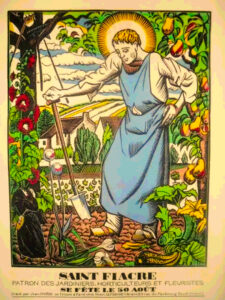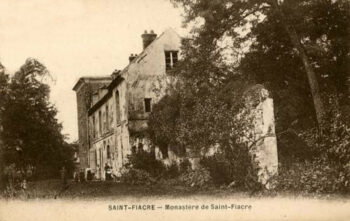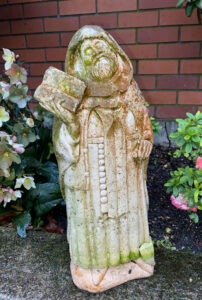September Saint
 Saint Fiacre - 1 September
Saint Fiacre - 1 September
What do gardeners, sufferers from haemorrhoids, florists and taxi drivers have in common? They all have St Fiacre as their patron. There are at least two other Irish saints who bear the same name – but these have diffused into history like smoke from a garden fire… St Fiacre of Breuil, to give him his proper title, is the man whose feast day is the 1st of September and whom we remember now.
You may have seen small white statues of a monk in somebody’s garden. There’s one that welcomes visitors to the offices of the Marist Messenger. That’ll be St Fiacre.
St Fiacre has enjoyed a bit of a renascence among gardeners since garden centres began selling his statue. It seems some people are betting on a bit of holy intercession when they tend their garden! It is less common to see such a statue in a taxicab…
 Fiacre was born in Ireland around the year 600. He was raised in a monastery and became a monk. He was ordained as a priest at some stage and eventually became abbot. His monastery was possibly near Cill Fiachra (Kilferagh) in County Kilkenny. He became skilled in herbal medicine, but it was his reputation for holiness and the gift of healing that drew crowds of people to him. So he journeyed to France in search of monastic solitude in 628. St Faro, the bishop of Meaux, gave him a site near Breuil (now called Saint-Fiacre) in the province of Brie. The bishop told him he could have as much land as he might cultivate in one day with a plough. Fiacre worked the soil with the end of his staff, uprooting trees, thorns and weeds. A suspicious woman tattled to St Faro that Fiacre was working witchcraft. However, the bishop recognised that Fiacre was doing the work of God. Legend has it, that as a result, Fiacre determined that women would not enter the precincts of his hermitage. However, this was a common practice in monasteries in the Middle Ages and beyond.
Fiacre was born in Ireland around the year 600. He was raised in a monastery and became a monk. He was ordained as a priest at some stage and eventually became abbot. His monastery was possibly near Cill Fiachra (Kilferagh) in County Kilkenny. He became skilled in herbal medicine, but it was his reputation for holiness and the gift of healing that drew crowds of people to him. So he journeyed to France in search of monastic solitude in 628. St Faro, the bishop of Meaux, gave him a site near Breuil (now called Saint-Fiacre) in the province of Brie. The bishop told him he could have as much land as he might cultivate in one day with a plough. Fiacre worked the soil with the end of his staff, uprooting trees, thorns and weeds. A suspicious woman tattled to St Faro that Fiacre was working witchcraft. However, the bishop recognised that Fiacre was doing the work of God. Legend has it, that as a result, Fiacre determined that women would not enter the precincts of his hermitage. However, this was a common practice in monasteries in the Middle Ages and beyond.

Saint Fiacre outside the Marist Messenger Office
On the land granted to him, Fiacre built a hermitage for his dwelling, installed a vegetable and herb garden, an oratory in honour of the Blessed Virgin Mary and a hospice to welcome travellers. There he lived a life of monastic austerity in prayer, fasting, and manual labour in his garden. Fiacre became famous for his healing powers, by laying on of hands and use of poultices made from herbs. Apparently he had great success with haemorrhoids, which became known as “le fic de S. Fiacre” (Figs of St Fiacre)! Legend also holds he caused his blind sister, the nun Syra, to be cured by identifying the site where the remains of St Savinien lay. By prostrating herself on the grave, praying and weeping, her sight was miraculously restored.
Fiacre died on the 18th of August, 670 and his body was buried in the church of the hermitage. A village grew up around the shrine, now called Saint-Fiacre. Later, relics of his remains were interred in Meaux Cathedral. Among those who made the pilgrimage to Fiacre’s relics were notable people such as King Louis XIII of France, his wife: Anne of Austria, St John of Matha, and St Vincent de Paul. Cardinal Richelieu (well known as L’Éminence rouge for his political and ecclesiatical intrigues) also came to venerate Fiacre’s relics, hoping to be relieved of the haemorrhoids that afflicted him.
Fiacre, in addition to being the patron saint of gardeners and proctologists (and their patients), is patron saint of taxi drivers. How did this come about? More prosaically, the Hotel de Saint Fiacre in Paris, from about 1650, began to hire out carriages. These came to be known as fiacres which in turn became a generic term for hired transport. Fiacre was soon claimed as a patron by Parisienne taxi drivers. He is venerated on either the 30th of August or the 1st of September. St Fiacre, watch over our garden this spring!
 Entries(RSS)
Entries(RSS)